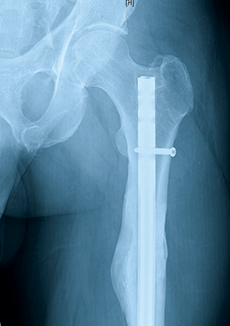Trauma
Protocol-Based Management for Geriatric Hip Fracture
A multidisciplinary team with representatives from orthopedics, anesthesiology, geriatrics, nursing, physical therapy, and social work is establishing a standardized protocol in the management of hip fracture in the elderly to be implemented throughout NewYork- Presbyterian. Recommendations include expediting surgery within 24 to 48 hours of presentation and using anterior approach hip arthroplasty for displaced femoral neck fractures that minimizes soft tissue damage, allowing patients to mobilize more quickly.
Medical-Orthopedic Trauma Service
Through its Medical-Orthopedic Trauma Service (MOTS), NewYork-Presbyterian continues to serve as a model to ensure optimal outcomes for geriatric patients with hip fractures. MOTS, an innovative partnership between the Department of Medicine and the Trauma Service at NewYork-Presbyterian/Weill Cornell Medical Center, is designed to improve care through a coordinated plan of treatment involving orthopedic surgeons and general internists, as well as orthopedic and medical house staff, nurse practitioners, physician assistants, social workers, physical therapists, and nursing staff. Their goal is to operate on the patient swiftly to minimize the risk of hip fracture disease, as well as to identify and manage all other medical and social issues that may have contributed to the fall.
Trauma Training Center
Established 25 years ago by Melvin P. Rosenwasser, MD, the Trauma Training Center at Columbia draws orthopedic surgeons and researchers from around the world to learn principles and techniques from our trauma specialists. The Center also serves as a research laboratory for orthopedic trauma, hand, and upper extremity surgery, and has been enormously successful at conducting prospective and retrospective clinical studies and clinical and biomechanical basic science research with the goal of developing new surgical techniques to optimize outcomes for injured patients.

Case Study
A 45-year-old man struck by a car sustained a closed left femoral shaft fracture. He was treated at a regional trauma center with intramedullary nailing. One year after injury, he presented to our trauma experts at NewYork- Presbyterian/Columbia with ongoing left thigh pain. Although X-rays suggested healing and the patient was told his fracture had healed, CT scan showed a nonunion.
On exam, the patient had a large soft tissue fluid collection on the left lateral thigh consistent with a Morel-Lavallée lesion. Once the nonunion was identified by CT, the surgical plan for exchange nailing was straightforward. However, the huge cystic soft tissue lesion was more challenging.
In surgery, an exchange nailing with reaming was performed, bringing the nail up 2mm in diameter. A huge fluid collection was seen, debrided, and sutured closed over a drain. Both the nonunion and the Morel-Lavallée lesions healed quickly after revision surgery. Postoperative X-ray at one year shows excellent bone healing. The patient has resumed his career as a construction contractor.



